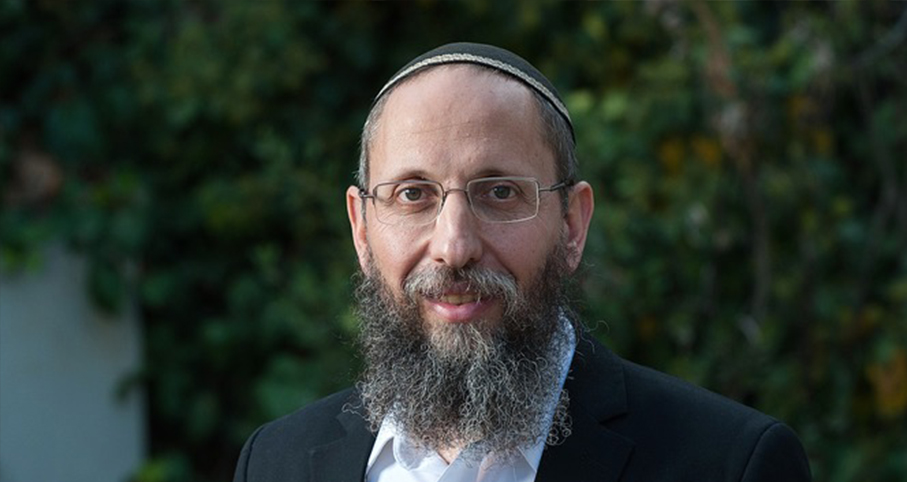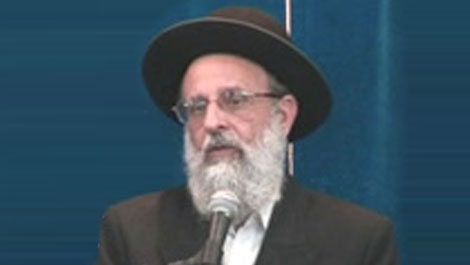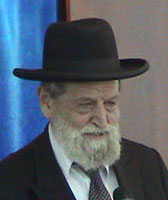Beit Midrash
- Torah Portion and Tanach
- Shmot
- Va'era
Why was a brocha created to commemorate the events that transpired in Beitar?
Question #2: Why in Birkas Hamazon?
Why was that brocha added to Birkas Hamazon?
Question #3: What a strange brocha!
Why does the brocha Hatov Vehameitiv have such an unusual structure?
Introduction:
The fourth brocha of bensching, which is called Hatov Vehameitiv, has little to do with the rest of the bensching. Whereas the first three brochos are to thank Hashem for our sustenance, the fourth brocha was created by Chazal for a completely unrelated reason. This brocha is called Hatov Vehameitiv because of the words it contains, "hamelech Hatov Vehameitiv lakol." This article will discuss some of the halachos and concepts of this unusual brocha.
Although in two different places (Brochos 46a; 49a) the Gemara quotes opinions that this fourth brocha is min haTorah, the consensus is that it is only rabbinic in origin. (We should note that the Midrash Shmuel [13:9] attributes the opinion that Hatov Vehameitiv is min haTorah to a very early authority, the tanna, Rabbi Yishmael.) To quote the Gemara:
Hatov Vehameitiv was established by the Sanhedrin when it was located in Yavneh, because of those who were killed in Beitar, as noted by Rav Masneh, "On the very day that those killed in Beitar were allowed to be buried, they established, in Yavneh, Hatov Vehameitiv. ‘Hatov’ is to acknowledge that their bodies did not decompose; ‘Vehameitiv’ is to acknowledge that permission was granted to bury them" (Brochos 48b; Taanis 31a; Bava Basra 121b; see also Yerushalmi, Taanis 4:5).
Hatov Vehameitiv
To avoid confusion, we must realize that there are two completely different brochos that Chazal call Hatov Vehameitiv. The other brocha, which is only eight words long, Boruch Attah Hashem Elokeinu Melech ha’olam Hatov Vehameitiv, is recited upon hearing certain special, wonderful events or when breaking out a new bottle of wine. The laws germane to the shorter brocha will be left for a future article.
What happened in Beitar?
The Mishnah in Taanis (26b) records the calamities that occurred on Shiva Asar beTamuz and on Tisha Be’Av. Regarding Tisha Be’Av, it states, "On the ninth of Av, it was decreed upon our forefathers that they would not enter Eretz Yisroel, both the first and the second Batei Mikdash were destroyed, the city of Beitar was conquered, and the city of Yerushalayim was plowed under." The Talmud Yerushalmi (Taanis 4:5), quoting the tanna, Rabbi Yosi, dates the destruction of Beitar as being 52 years after the churban of the second Beis Hamikdash, or, almost exactly 1900 years ago.
To understand the extent of the tragedy that happened in Beitar, let us quote some of the sources of Chazal.
A large city called Beitar, whose population was many tens of thousands of Jews, was ruled by a great Jewish king. All the Jews, including the greatest of the chachamim, thought that this king was the Moshiach, until he fell in battle to the non-Jews and the entire city was slaughtered (Rambam, Hilchos Taanis 5:3).
The Roman emperor Hadrian owned a massive vineyard, twelve mil long and twelve mil wide (about fifty square miles). The Romans used the bodies of those who were killed when Beitar was destroyed as a wall, the height of a man, around the vineyard. Hadrian refused to allow the casualties of Beitar to be buried. Only with the succession of a new emperor was their burial permitted (Yerushalmi, Taanis 4:5).
The city of Beitar had 400 shuls, each of which had 400 cheder rabbei’im teaching in them, and each rebbe taught 400 children. When the Romans conquered the city, they wrapped all the students and all the teachers in their seforim (which, in their day, were rolled like scrolls) and set them ablaze (Gittin 58a).
Enough pairs of tefillin shel rosh were found from those who died in Beitar to fill a mikveh. According to a second opinion, enough pairs of tefillin shel rosh were found to fill three mikvaos (Gittin 57b).
For seven years, the non-Jews fertilized their vineyards, exclusively, with the Jewish blood of those who were martyred in Beitar (Gittin 57a).
Fifteenth of Av
We should also note the following passage of Gemara: "No festivals of the Jews were celebrated to a greater extent than were the Fifteenth of Av and Yom Kippur. We understand why Yom Kippur has this unique quality – it is the day that forgiveness is granted – but why the fifteenth of Av?" Among the many answers the Gemara provides is "Rav Masneh explained, because that was the date when permission was granted to bury those killed in Beitar" (Taanis 30b-31a).
An unusual brocha
Now that we know a bit about the history behind this brocha, let us discuss the brocha itself, particularly, its structure. Of the many questions that we can ask, let us focus on the following three, which were our opening questions:
1. Why was a brocha created to commemorate this particular calamity?
2. Why was that brocha made part of Birkas Hamazon?
3. Why does this brocha have such an unusual structure?
1. Why a brocha?
Why was a brocha created to commemorate this particular calamity?
Unfortunately, there have been many catastrophes in Jewish history, which we have, thank G-d, survived, but we do not have extra brochos to commemorate them (Kenesses Hagedolah, Tur Orach Chayim 189). Most tragedies are commemorated with fast days and the recital of selichos, and most miraculous events are celebrated on their anniversary, but not with a brocha that we recite daily.
These questions are already asked by very early authorities, who suggest the following answers:
The tragedy of the destruction of Beitar was great and unique in the bizayon haTorah that resulted, when thousands and thousands of observant Jews lay unburied. When Hadrian died, and his successor permitted their burial, Chazal felt the need to demonstrate, significantly, that this chillul Hashem had ended and was, on the contrary, accompanied by a tremendous kiddush Hashem, that the bodies of the fallen had not deteriorated, notwithstanding that they had been exposed to the elements for many years.
In addition, the events of Beitar teach that, even when Hashem is angry at us, He still performs miracles. This is to teach us that Hashem never abandons us, even at times when we sin and deserve punishment (Aruch Hashulchan, Orach Chayim 189:2)
2. Why in bensching?
Why did Chazal place this brocha in bensching (Rosh, quoted by Tur, Orach Chayim 189)? The rest of Birkas Hamazon is acknowledgement to Hashem for providing for us and for the wonderful land of Eretz Yisroel that He gave us. Why commemorate the tragedy of Beitar during Birkas Hamazon?
This brocha was instituted in Birkas Hamazon as a constant reminder (Shu"t Binyamin Ze’ev #351; Shu"t Mishpetei Shmuel #11). In addition, it was placed in Birkas Hamazon, which is, in its entirety, thanks to Hashem (Rosh, Brochos 7:22). Furthermore, the Rosh notes that the Yerushalmi (see our version, Sukkah 5:1 at end) states that the loss that the Jews suffered at Beitar will not be restored until the Moshiach comes. It is unclear to which specific loss this Gemara is referring, but regardless, this is another reason why the brocha of Hatov Vehameitiv was placed immediately following the brocha of Boneh Yerushalayim.
Several prominent gedolim provide an additional reason why this brocha was added specifically to bensching. After celebrating a joyous meal, people might lose sight of life’s priorities. To prevent this from happening, Chazal instituted a brocha reminding people of the tragedy of Beitar (Rabbeinu Bachya, Kad Hakemach #60; Shu"t Binyamin Ze’ev #351). This is similar to the idea of breaking a glass at a wedding and mentioning the churban then, so as to keep our celebrations in a balanced perspective. We celebrate, but still need to remember that we are missing important aspects of life that we require as Jews.
Why not in Shemoneh Esrei?
The Binyamin Ze’ev, who lived in Greece and in Venice, Italy, during the first half of the sixteenth century, asks that, if Chazal wanted the association of this new brocha to be with the rebuilding of Yerushalayim, why was the brocha placed in Birkas Hamazon and not in the weekday Shemoneh Esrei, after Boneh Yerushalayim?
The answer is that inserting this brocha in the midst of the Shemoneh Esrei would be an interruption, whereas at the time that Chazal incorporated this fourth brocha into Birkas Hamazon, bensching included only the Torah required portions, which end with the words Boneh Yerushalayim (Aruch Hashulchan, Orach Chayim 189:1). (The other requests that begin with the word Harachaman, the pesukim that we traditionally recite at the end of the bensching, and the blessing we recite for the household where we ate were all added to Birkas Hamazon after this time in history.)
Text of brocha
3. Why does this brocha have such an unusual structure?
Let me explain. The numerous brochos that we recite daily follow three specific structural patterns:
A. Either they are very short brochos, such as those that we recite prior to eating, performing mitzvos, seeing unusual sites, or enjoying other pleasures, which begin with the words Boruch Attah Hashem Elokeinu Melech ha’olam and then close with the appropriate ending. These are called brochos ketzaros, short brochos.
B. A second structure of a brocha is the most common for a longer brocha. This type of brocha begins with the same words, Boruch Attah Hashem Elokeinu Melech ha’olam, and ends the brocha by repeating the words Boruch Attah Hashem and closing with the theme of the brocha. These brochos are called brochos aruchos, long brochos.
Part of a series
C. The third type of brocha is one that follows another brocha in a series. Such a brocha does not begin with Boruch Attah Hashem Elokeinu Melech ha’olam, but ends with Boruch Attah Hashem and closes with the theme of the brocha. This type is categorized as a brocha hasemucha lachaverta, literally, a brocha that follows another brocha; in other words, a brocha that is part of a series. For this reason, the brochos of Shemoneh Esrei, the brochos that surround the Kerias Shma, and the second and third brochos of Birkas Hamazon do not begin with Boruch Attah Hashem Elokeinu Melech ha’olam (except for the first brocha in the series). All begin by explaining the theme of the brocha and end with Boruch Attah Hashem and an appropriate conclusion.
The brochos of bensching
Now that we realize that all brochos fit into one of three categories, let us examine the four brochos of Birkas Hamazon and see under which category each brocha belongs.
The first brocha, Ha’zon es ha’olam, begins with the words Boruch Attah Hashem Elokeinu Melech ha’olam and closes with Boruch Attah Hashem hazan es hakol, "He who sustains all." This structure fits our rules nicely, as category B: It is a classic "long brocha."
The second and third brochos are part of a series and, therefore, do not begin with a brocha, but end either with the words Boruch Attah Hashem al ha’aretz ve’al hamazon, or with Boruch Attah Hashem boneh (berachamav) Yerushalayim. This follows the rule of brocha hasemucha lachaverta, a brocha that follows another brocha, which we called category C.
The unusual fourth
However, the fourth brocha of Birkas Hamazon does not seem to fit any of the above three categories. It begins with the words Boruch Attah Hashem Elokeinu Melech ha’olam, which means it is not considered part of a series. Although it is always recited as the fourth brocha of Birkas Hamazon, immediately after the brocha of Boneh Yerushalayim, and you would think that it should be considered part of a series (Tosafos, Brochos 46b s.v. Vehatov), our introduction can help explain why it is not. Since this brocha was not originally part of Birkas Hamazon, but was added for a completely unrelated reason, it is considered a beginning brocha and not a brocha hasemucha lachaverta.
Which remaining category?
The list above contains two categories of brocha that begin with the words Boruch Attah Hashem Elokeinu Melech ha’olam: category A, the short brochos, and category B, the long brochos. However, Hatov Vehameitiv does not seem to fit either category. It is too long to be considered a short brocha, nor does it follow the structure of a long brocha, since it does not end with Boruch Attah, Hashem and a closing.
As you can imagine, we are not the first to raise this question. The rishonim do, and provide three answers to resolve this conundrum. But first, we need to provide another introduction.
Chazal instituted that the brocha of Hatov Vehameitiv should include three references to Hashem being King, a concept that Chazal call malchus (Brochos 47a). This we do, when we recite the following: (1) the word melech in the very beginning of the brocha, Boruch Attah Hashem Elokeinu Melech ha’olam, (2) the next words of the brocha are ha’keil avinu malkeinu, (3) ro’einu ro’eih Yisroel hamelech hatov (Divrei Chamudos, Brochos 7:69).
Why three times? The Gemara (Brochos 49a) explains that since the third brocha of Birkas Hamazon (that ends with the words, Boneh Yerushalayim) mentions the kingdom and royal family of David, there should be mention of Hashem’s monarchy in all four brochos of Birkas Hamazon. However, the mention of Hashem’s malchus that should be in the second and third brochos of Birkas Hamazon are delayed until the fourth. (The first brocha of Birkas Hamazon, begins with Elokeinu Melech ha’olam, and therefore contains a reference to Hashem’s monarchy.) Thus, in addition to the basic theme of acknowledgement and thanks to Hashem for His performing a miracle, Chazal added a theme to the brocha of Hatov Vehameitiv, making sure that Hashem’s malchus is mentioned three times.
Three hatavos
The rishonim quote a midrash that states that Chazal required adding to the brocha of Hatov Vehameitiv three hatavos: We are to say three times that Hashem is beneficial to us. Although I was unable to locate this midrash, it definitely existed at the time of the rishonim but has been lost since their era.
Among the rishonim, I found several different texts for this concept. The standard nusach Ashkenaz says hu heitiv, hu meitiv, hu yeitiv lanu, "He has done good, He does good, and He will do good to us". The Rosh discusses the correct text, and concludes that the correct text should be hu heitiv lanu, hu meitiv lanu, hu yeitiv lanu, with the word lanu repeated each time ("He has done good to us, He does good to us, and He will do good to us."). The Shulchan Aruch rules that this is the correct practice, and this is the standard, accepted nusach used by eidot hamizrah and Sefardim. This is a very interesting point, because the Rosh is usually the source for minhagei Ashkenaz that differ from Sefardic practice, and here, he is the source for the Sefardic custom, and most Ashkenazim do not follow his approach.
Hu Gemalanu
In addition, the rishonim mention that we should also mention three times that Hashem grants us good, which we add with the words, hu gemalanu, hu gomleinu, hu yigmeleinu la’ad – "He granted us, He grants us and He will grant us forever…"
Why no ending?
Thus, we see that the brocha of Hatov Vehameitiv is a long brocha, and yet it does not end with the words Boruch Attah Hashem and a closing, as a long brocha normally does.
Why not?
Again, the rishonim raise this question and provide several differing approaches to answer it. Rabbeinu Yonah (Brochos 36a) quotes two reasons:
I. Notwithstanding that the brocha is somewhat lengthy, it is still considered a short brocha, because all the ideas included are simply different aspects of the same theme – that Hashem is Hatov Vehameitiv.
II. When the original brocha was created, Hatov Vehameitiv was a short brocha that did not warrant an ending. Although other parts were gradually added, the original structure of the brocha was not changed (see also Tosafos, Brochos 46b s.v. Vehatov).
III. The Rashba (Brochos 46a s.v. Teida) provides a third answer. Although this brocha should have been a long brocha, Chazal did not treat it as such, because they did not want this brocha, which is miderabbanan, to be more prominent than the two brochos that proceed it, which are min haTorah and which each have the words Boruch Attah Hashem only one time. Therefore, they decided to omit an ending to this brocha, making it an exception to the rule.
Conclusion
The most important message of Birkas Hamazon is our expressing thanks to Hashem for everything He provides for us. We see how Chazal also wanted us to remember to thank Hashem for kindnesses that He did for our people, thousands of years ago. It certainly behooves us to recite the Birkas Hamazon carefully and with kavanah, and to demonstrate at least a small expression to praise Hashem.
This Shiur is published also at Rabbi Kaganof's site

























